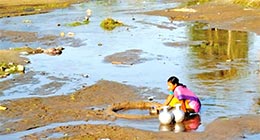NEW DELHI – World Water Day is over, and the world moves on to other matters. A global water crisis continues, nonetheless. A crisis already exists for many people in South Asia and there are indications that conditions could get worse before they get better.
Almost 600 million people in India are at high risk of being unable to continue relying on surface water — including in the country’s northwest and south, where much of the country’s staple wheat and rice are grown, according to the World Resources Institute.
Water supply in India may fall 50 per cent below demand by 2030, the Asian Development Bank has forecast.
“Large parts of India have already been living with ‘Day Zero’ for a while now,” said Mridula Ramesh, author of an upcoming book on climate change.
“Much of it is because of bad management. Most cities lose between a third and a fifth of their water from pilferage or leakage through antiquated pipes, and we don’t treat and reuse wastewater enough,” she said.
When a water shortage occurs in one specific locale, it is much easier to define the cause and to remedy it. The smaller the locale, the easier it is to address the problem. The broader the affected area, the more difficult it can be to define the underlying issues and exponentially more difficult to address them. South Asia is one of those large-scale areas where people live on or beyond the brink of a growing water crisis.
Consider these few facts.
Apart from in Bhutan and Nepal, South Asia’s per capita water availability is already below the world average. The region could face widespread water scarcity — less than 1,000 cubic meters available per person according to a South Asia water expert in Washington, DC.
Bangalore, Karachi and Kabul are among the 10 cities in the world that are “on the verge of an imminent water crisis”, according to a report last month by the Centre for Science and Environment (CSE), a research and advocacy group based in New Delhi.
Nearly 163 million people among India’s population of 1.3 billion — or more than one in 10 — lack access to clean water close to their home, according to a 2018 WaterAid report.
Almost 600 million people in India are at high risk of being unable to continue relying on surface water — including in the country’s northwest and south, where much of the country’s staple wheat and rice are grown, according to the World Resources Institute.
Water supply in India may fall 50 per cent below demand by 2030, the Asian Development Bank has forecast.
Of course, we can continue to cast blame on each other. There are just so many causes for the water crisis. The earthquake in Nepal changed the course and access to previous water sources.
The ‘Day Zero’ scare in Cape Town was, in large part, a result of a season of persistent drought. In some cases, particularly across national borders, upstream water control efforts adversely affect people living downstream. The construction of dams on major rivers can have serious implications for millions living downstream. This has been the case for countries like China, Tibet, India, and Bangladesh.
No matter what particular cause or causes contribute to a lack of water across parts of South Asia, the fundamental issue is there is not enough water available to support the growing population. Conversely, the population is outgrowing the water resources available.
But the issue is, really, much more complex. Population shifts affect the ability of water authorities to have any lasting control. The Diplomat reports that in Bangladesh, like many other countries, “the water supply in major cities is the responsibility of city authorities, but in rural areas that authority is missing.”
Demand for water in the capital Dhaka is 2.2 billion liters a day, while production is 1.9 billion liters a day.
Chittagong, the second largest city, supplies 210 million liters each day against demand for 500 million liters.
Press releases from the Government of India Press Information Bureau have reported measurable percentage declines in 91 major reservoirs for several months. Water levels are reported to be at an average of 23% of capacity.
The News Observer summed up the situation, observing that all of this is . . . due to overpopulation and nothing else. Simply put, the [population of South Asia] is [growing] so fast that the natural resources of their lands are unable to sustain such rapidly growing populations.
INDIA in WATER CRISIS
Nearly 163 million people among India’s population of 1.3 billion — or more than one in 10 — lack access to clean water close to their home, according to a 2018 WaterAid report.
That is the most of any country in the world, according to the UK-based charity, which aims to provide clean water and better hygiene to people without them.
Disputes with neighbours over the sharing of water from rivers that cross national boundaries also means tensions are rising as water shortages grow, said Michael Kugelman, a deputy director and South Asia expert at the Wilson Centre, a policy think tank in Washington DC.
“Countries that get along the least are forced to share and cooperate over water resources, and many major rivers originate in, or pass through, politically contested and tense areas,” he told the Thomson Reuters Foundation.
“So you have population growth, intensifying climate-change impacts, poor water management and geopolitical tensions. It’s a perfect storm for greater water insecurity,” he said.
India is entangled in water disputes with its eastern and western neighbours — Bangladesh and Pakistan — which accuse it of monopolising water flows moving downstream toward them.
To the north and northeast, however, India fears a loss of water to upstream China, which plans a series of dams over the Tsangpo river, called the Brahmaputra as it flows into eastern India.


